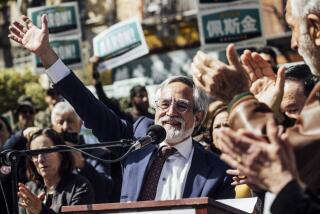Sea Change in Santa Monica
- Share via
“The radicals ... haven’t renamed Santa Monica ‘Ho Chi Minh City,’ but if they did, the people who used to rule here -- the conservatives, the landlords, the developers, the business people -- wouldn’t be at all surprised.”
-- “60 Minutes,” 1982
*
Did somebody once talk about a “People’s Republic of Santa Monica”?
Nowadays, Santa Monica seems more like Beverly Hills run by the Green Party.
The city once synonymous with the liberal causes of Tom Hayden and Jane Fonda is filling up with new People’s Republicans who earn a median income of $90,000 a year. Designer boutiques have eclipsed mom-and-pop stores on Montana Avenue, giving the street a haughty affluence more familiar along Rodeo Drive.
The ZIP Code north of Montana Avenue has become a gated community without a gate. Private patrol cars prowl a mushrooming array of newly minted monster mansions whose square footage is among the county’s most valuable.
Ever wonder what would happen if the Woodstock generation got rich? Check out the bourgeois bohemians at Montana’s organic grocer. Choose homeopathic remedies--or “Hemp Plus” frozen waffles--to the soothing midlife angst of Eric Clapton. “Yogi” Green Tea offers yoga poses on the box.
To civic boosters anywhere else, this New Age-meets-Gilded Age might mean success.
But a sense of unease, even guilt, hangs over the place, as if some people are debating whether Santa Monica should be sister city to Brentwood or Berkeley.
Just last week, the Santa Monica City Council wound up an emotional debate with the passage of two laws aimed at containing homeless people--long the beneficiaries of local liberal largess.
Another litmus test comes in November. Voters will face a referendum intended to overturn an ordinance that mandated a $10.50 “living wage” that was to have taken effect in July for workers on the ocean-front tourist strip.
The issue taps into a widening fault line of class struggle: Not everyone who works in Santa Monica can still afford to live there. Stockbrokers are moving in. Artists are moving on.
“The term ‘Beverly Hills-by-the-sea’ is what is often used here to sum up the fear. No offense to Beverly Hills, but this is a different community,” said Santa Monica Mayor Michael Feinstein, 43, a ponytailed Green Party leader. “Our real challenge is dealing with too much success. We have a situation where, if we let capitalism run amok, it will run right over us.”
Some say it already has.
Rent control, a cornerstone of Santa Monica liberal politics, now defers to a state law, enacted in January 2001, allowing landlords to raise the rents of vacant units to market rates.
The migration of entertainment firms to Santa Monica’s new office park in the mid-1990s accelerated a huge real estate run-up.
“These guys got the idea that entertainment was the biggest clean, nonpolluting industry, and authorizing these big flashy developments was the way to attract it,” said “Saturday Night Live” veteran Harry Shearer, whose Sunday morning radio satire, “Le Show,” broadcasts from Santa Monica, which he nicknames “Home of the Homeless.”
Allowing residents to seal off their streets with permit parking “seems elitist for a leftist City Council,” he said. “I think of them more like the current Chinese, who proclaim a left-wing ideology but maintain Hong Kong and Shanghai as bastions of capitalism. One thing this town lacks is real bohemians, so I guess pretensions is as close as we’re going to get.”
Feinstein, with his sandals, floppy shorts and hooded Green Party sweatshirt, seems to embody the counterculture ethos that plucked Santa Monica from conservative obscurity to the attention of the Free World.
Instead of meeting at Starbucks (“because of the corporate stuff”) Feinstein invites a reporter to an Ocean Park cafe where the tip jar reads “Karma.”
Feinstein came to Santa Monica in 1983 when the sleepy 127-year-old beach town was waking up and turning into “this deliberately funky place to be,” Feinstein recalled.
“Here you could be an individual without breaking the mold and be seen as going against the crowd,” he said.
Santa Monica was filling up with the cultured bohemians who, as in San Francisco, Big Sur and New York’s SoHo, turned out to be the improbable advance men and women for gentrification. They proved that alternative lifestyles and success need not be mutually exclusive.
Or, as Jackson Browne put it, once upon a time “we were all hippies. Some of us got rich off music” -- and other counterculture industries.
Feinstein, a native of Minnesota, had gotten a degree in philosophy from Carleton College there and backpacked through Europe, where he encountered Green Party leaders who “made me realize that, rather than going to a mountaintop in the Himalayas, I should see how those feelings of inter-connectedness fit in the real world.”
He decided Santa Monica was the place to connect. He lived in his Volkswagen van and worked as the California sales representative for an “under-capitalized cottage industry” started by a high school buddy. It was called “Rollerblade.”
“It taught me how to sell a trend,” he said. “It taught me how to sell a new party.”
He connected with a pool of liberal activists who were challenging the city’s conservative establishment.
One of them was Vivian Rothstein, who was active in the increasingly powerful renters’ rights coalition. In 1979, the coalition had formed a voting bloc and won passage of local rent control.
In those days, scrawled reds-under-the-bed slogans -- like “Soviet Monika” -- turned up on walls with red hammers and sickles. One slogan -- the “People’s Republic of Santa Monica” -- was delightedly co-opted by the city’s new radical chic leadership. Rothstein, now a leader of the campaign to preserve the living wage ordinance, sees new signs of the times: private jets depositing people at the Santa Monica Airport and Jaguars driving them off.
“It’s like this monster that’s trying to take us over,” she said.
But the city that spends so much time thinking about organic vegetables for school lunches and “green” city conservation practices can’t do much to curb the market forces unleashed by gentrification.
Property values are so ginned up that acquiring land for city parks is prohibitively expensive. Yet a 2001 survey found just 10% of city residents listed affordable housing as a vital problem, compared with 23% the year before.
In a housing market where teardowns can cost over $1 million, a proposal to set up a new historic district has triggered fighting words. On one side are longtime homeowners who resent the new “monster mansions” that tower over older homes. On the other side are affluent newcomers who want to replace homes 40 or more years old and do not want the landmarks commission in the way.
The ordinances designed to contain homeless people were prompted by complaints from the public. One makes it illegal for people to sleep or sit in doorways on Main Street overnight -- if the merchants post signs asking them not to do so. Another, designed to limit free outdoor meals, requires groups serving 150 or more people to adhere to community event laws and county health standards.
Feinstein suggested that the ordinances were bad karma. During the debate, advocates for the homeless held a prayer vigil. One said the ordinances would “criminalize charity.”
But supporters said the measures were long overdue. “The public is scared and tired and just generally want it stopped,” Councilman Herb Katz said.
Now a coalition of developers is backing efforts to overturn the ordinance that would obligate nonunion businesses grossing more than $5 million a year along Santa Monica’s tourist strip to pay the “living wage.”
That’s about double the federally mandated minimum -- but cheaper than many Santa Monica hors d’oeuvres.
In the eyes of critics like Shearer, these issues are not as simple as robber barons versus oppressed workers. For one thing, everybody knows affluent yuppies “making out like bandits” in rent-controlled apartments, Shearer said. The living wage measure gives businesses a stone’s throw away from the affected ocean-front district a higher profit margin. And why, he asks, are unionized businesses exempt?
But, then, many things in Santa Monica are contrarian.
Local millionaires support anti-establishment causes. Yuppies line up to get kids into Santa Monica’s dual Spanish-English immersion school, while neighboring Los Angeles remains polarized over bilingual education.
Santa Monica, one of the region’s most desirable places to live, is losing population as lower-income families move out and high-earning singles move in. The 2000 census found 84,000 residents, down from estimates of more than 91,000 in 1998.
The city has drafted a plan to create hundreds of units of affordable housing. Opponents say the liberal council is trying to bolster its own constituency in the face of challenges on the horizon.
Another initiative on the ballot, called Veritas, would require City Council members, now elected at large, to run by district. It calls for the mayor, who is now chosen by the council, to run citywide. Veritas supporters argue that district representatives would be more responsive to things like street repairs and tree-trimming -- and “bring less ideological people to the City Council,” said Veritas leader Paul DeSantis.
Veritas backers, which included big business, also point to a 1992 city report that concluded that the enactment of the at-large system in 1946 may have sprung from a desire to minimize the influence of a growing World War II-era black community. The Pico neighborhood, now home to a large Latino community, might more easily elect a Latino representative to the all-white City Council under a district system, DeSantis said. “In progressive Santa Monica, no one has been elected from the minority Pico neighborhood to the City Council in 56 years.”
Feinstein dismisses Veritas as a Trojan horse by living wage opponents eager to unseat the current City Council and run a pro-development mayor.
This November will test who holds the balance of power.
The old agitators of the People’s Republic are hardly gone, though some have moved to even tonier confines outside the city. Many of those who remain are now part of California’s moneyed liberal establishment.
“It’s like Jerry Brown says in Oakland, ‘Do you prefer slumification or gentrification?’ ” said John Densmore, the former drummer for the Doors and a lifelong Santa Monica activist. “Santa Monica is not Bel-Air or Beverly Hills. I hope the Berkeley element doesn’t get booted out. I hope we can continue that heritage.”
More to Read
Sign up for Essential California
The most important California stories and recommendations in your inbox every morning.
You may occasionally receive promotional content from the Los Angeles Times.













